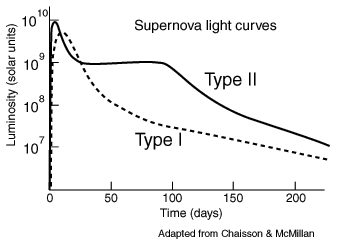This week I discuss types of supernovae, specifically relating to the scenario where “Hydrogen lines are prominent in Type II supernovae but absent in Type Ia. Type Ia supernovae decline gradually for more than a year, whereas Type II supernovae alternate between periods of steep and gradual declines in brightness. Type II light curves therefore have a step-like appearance. Explain!”

The question I really wanted to ask is ‘What happened to Type I or Ib?’ and the answer to that question was easily found in this chart:

But back to the explanation of why the light curves between the two types of supernovae are different.
Type I and II Supernovae
Supernovae are classified as Type I if their light curves exhibit sharp maxima (about ten (10) billion solar luminosities) and then die away gradually. Type II supernovae have less sharp peaks at maxima, peaking at about one (1) billion solar luminosities, and die away more sharply than the Type I. Type II supernovae are not observed to occur in elliptical galaxies, and are thought to occur in Population I type stars in the spiral arms of galaxies. Type I supernovae occur typically in elliptical galaxies, so they are probably Population II stars.

The model for the initiation of a Type I supernova is the detonation of a carbon white dwarf when it collapses under the pressure of electron degeneracy. The fact that the spectra of Type I supernovae are hydrogen poor is consistent with this model, since the white dwarf has almost no hydrogen. The smooth decay of the light is also consistent since most of the energy output would be from the radioactive decay of the unstable heavy elements produced in the explosion.
Type II supernovae are modeled as implosion-explosion events of a massive star. They show a characteristic plateau in their light curves a few months after initiation. This plateau is reproduced by computer models which assume that the energy comes from the expansion and cooling of the star’s outer envelope as it is blown away into space. This model is corroborated by the observation of strong hydrogen and helium spectra for the Type II supernovae, in contrast to the Type I. There should be a lot of these gases in the extreme outer regions of the massive star involved.

References
Comins, N. F. (2015). Chapter 12 the Deaths and Remnants of Stars. In Discovering the essential universe (6th ed., pp. 347-387). New Yor, NY: W.H. Freeman and Company.
Fraser, C. (2016, March 15). What are the different kinds of supernovae? Retrieved from https://phys.org/news/2016-03-kinds-supernovae.html
Nave, R. (n.d.). Supernovae. Retrieved from http://hyperphysics.phy-astr.gsu.edu/hbase/Astro/snovcn.html
Supernova Classification. (2017, November 7). Retrieved from https://en.wikipedia.org/wiki/Supernova#Classification
Supernovae. (2011, January). Retrieved from https://imagine.gsfc.nasa.gov/science/objects/supernovae2.html
Thompson, A. (2014, January 24). What Is a Supernova? Retrieved from https://www.space.com/6638-supernova.html
